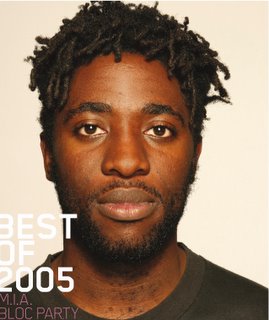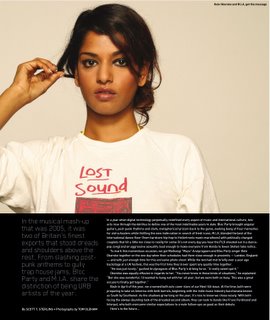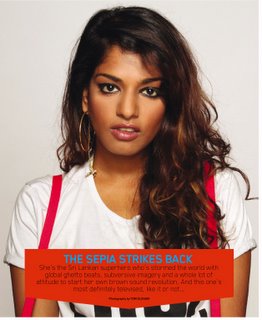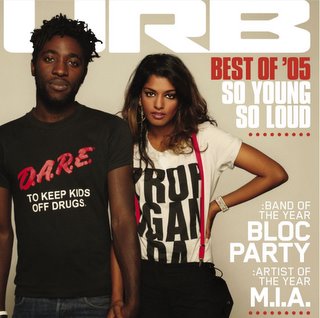
Youth is not wasted on teen punks Be Your Own Pet
By SCOTT T. STERLING
Wednesday, June 21, 2006 - 3:01 pm
The No. 1 enemy to any teenager in the world is boredom. Kids will do anything to avoid the B word, from wanton sex to trading prescription pharmaceuticals to forming a rock band (for the luckier parents out there). And despite what Chuck Klosterman may say in the June issue of Esquire, teenagers are alive and well in 2006. Exhibit A: new teen-punk heroes Be Your Own Pet, who are the polar opposite of boring.
These bona fide adolescents (all under 20), who formed BYOP at the progressive Nashville School of the Arts in 2002, seek to incite a white-hot riot of teen fury, their songs rushing by in a cacophonous flash (many clock in at 90 seconds), with the band — Nathan Vasquez (bass, afro), Jonas Stein (guitar) and Jamin Orrall (drums) — playing so fast they seem to race each other to the next tune (think Bad Brains beating the crap out of the Ramones). Much like the Yeah Yeah Yeahs, to whom they’re most often compared, deep inside these seething whippets of nervy energy lies a real sense of tunefulness and song craft that belies their age, and apparent ADD. The band’s writing skills shine brightest on “October, First Account,” which could very easily play as BYOP’s “Maps” (to really beat the YYY comparison to death). Somewhere between Cat Power gone electric and the Blake Babies’ younger siblings, BYOP even have the audacity (and capability) to toss a disco-reggae break into the song like some sort of mutant Blondie 2.0 without breaking a sweat. In case you haven’t been paying attention, this lot can really play, which is not something one can say about many of their teen-punk contemporaries.
They’re also fronted by this year’s most reluctant indie sex symbol, Jemina Pearl, whose almost embarrassingly fine profile is an obvious point of contention (at one point in our interview she mentions the proliferation of “creepy older guys” at their shows). You’ll be hard pressed to find a photo of the band where she’s even looking up, unless you count their conspicuous presence on the latest cover of trendy fashion monthly Nylon.
“Yeah, we’re on the cover of that magazine,” Pearl deadpans about the splashy spread. “It’s cool, I don’t know. They dressed us up in all of these stupid-looking clothes. I look ridiculous, I think. All of us do, really. It doesn’t even look like us. Whatever.”
They’ve already got the U.K. eating out of their hands: When the band took the stage at a massive U.K. festival last summer and nerves forced Pearl to vomit into a towel, fans begged for it (ew). She obliged by throwing it into the crowd, watching incredulously as they fought over its rancid contents (double ew). They also melted what seemed like a million hearts at this year’s SXSW fest — the hysteria mostly generated from their MySpace page, which had only been set up six weeks prior. In sum, BYOP — who cribbed their moniker from a song by Infinity Cat band Art Circus — have quickly become a pop phenomenon of genuine note.
When I track down Pearl and the rest of the band, it’s over the phone from Detroit, on the much-heralded 6/6/06 — the same day their eponymous debut album on Thurston Moore’s Ecstatic Peace! imprint hit American streets. Pearl is polite, but a young woman of few words. Or maybe I’m just boring.
“It’s no big deal,” she replies when asked if she’s seen the album on record-store shelves yet. “We were just down in Columbus, and a couple of stores had it out already. It was more exciting when it first came out in the U.K.,” she says nonchalantly — “but yeah, I’m excited that it’s out in America now too. It’s pretty cool.”
A far cry from the in-your-face exhibitionist that screams dogmatic teen slogans all over BYOP’s recordings (e.g., “I’m an independent motherfucker/And I’m here to take your money/I’m wicked rad/And I’m here to steal away your virginity” — “Bunk Trunk Skunk”) and whips audiences to hysteria at their notoriously short live shows. But she knows better. The members of BYOP were born into musical legacies. Pearl started singing in a church choir; her father is musician/artist Jimmy Abegg, while drummer Jamin’s father is noted songwriter Robert Ellis Orrall. These youngsters are wise in the ways of the industry, even one that’s heaped such hype on them it would be easy to crack (from profiles in Rolling Stone to a gushing review on Pitchfork).
Asked about her switch from the hymns to devil’s music, Pearl sneers, “Well, I’m not a Christian and don’t go to church, so it wouldn’t make sense for me to sing in a choir.” She adds, endearingly, “You don’t have to actually be good at singing to be in a rock band, you know?” But she can sing: Pearl’s clear vibrato and melodic fluency evoke a more operatic Debbie Harry.
“I love this band,” raves L.A. hipster guru Steve Aoki, an early BYOP fan. “Even at Coachella (this year), they only played a 15-minute set, sprayed shaving cream all over the place and jumped in the crowd. And it was just over. Awesome!”
“People don’t know us as well as they do overseas, so the shows aren’t, like, insane crazy,” Pearl surmises of their current American trek. “But having to win people over is part of the fun. We’re having a good time, and that’s all that really matters.”
You could say the medium is the message for these kids. Asked about the band’s manifesto, Pearl admits, “We’re not trying to put too much across. We’re just happy to be in a band, trying to have fun with it.” In other words, as young as BYOP may be, they’re aware of just how brilliant, beautiful and brief that time can be, and have chosen to honor it with loud, fast and vicious teen anthems. Sure beats the hell out of high school.
“We’ve gotten so many opportunities. So many bands don’t get the chance [to make records], which is unfortunate. But we’ve gotten that chance, so we’re trying to enjoy it.” She pauses, then adds, “Mostly, we’re just trying to find a way to buy beer.”
(Originally published in the LA Weekly, June 2006)


















